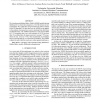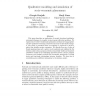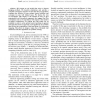396 search results - page 19 / 80 » How scientific models can explain |
ICIP
2007
IEEE
13 years 7 months ago
2007
IEEE
The Asynchronous Hidden Markov Model (AHMM) models the joint likelihood of two observation sequences, even if the streams are not synchronised. We explain this concept and how the...
JASSS
1998
13 years 7 months ago
1998
This paper describes an application of recently developed qualitative reasoning techniques to complex, socio{economic allocation problems. We explain why we believe traditional op...
NIPS
2008
13 years 9 months ago
2008
Young children demonstrate the ability to make inferences about the preferences of other agents based on their choices. However, there exists no overarching account of what childr...
CSL
2010
Springer
2010
Springer
The Hidden Information State model: A practical framework for POMDP-based spoken dialogue management
13 years 7 months ago
This paper explains how Partially Observable Markov Decision Processes (POMDPs) can provide a principled mathematical framework for modelling the inherent uncertainty in spoken di...
CEC
2007
IEEE
14 years 1 months ago
2007
IEEE
— We present an ant model that solves a discrete foraging problem. We describe simulations and provide a complete convergence analysis: we show that the ant population computes t...



